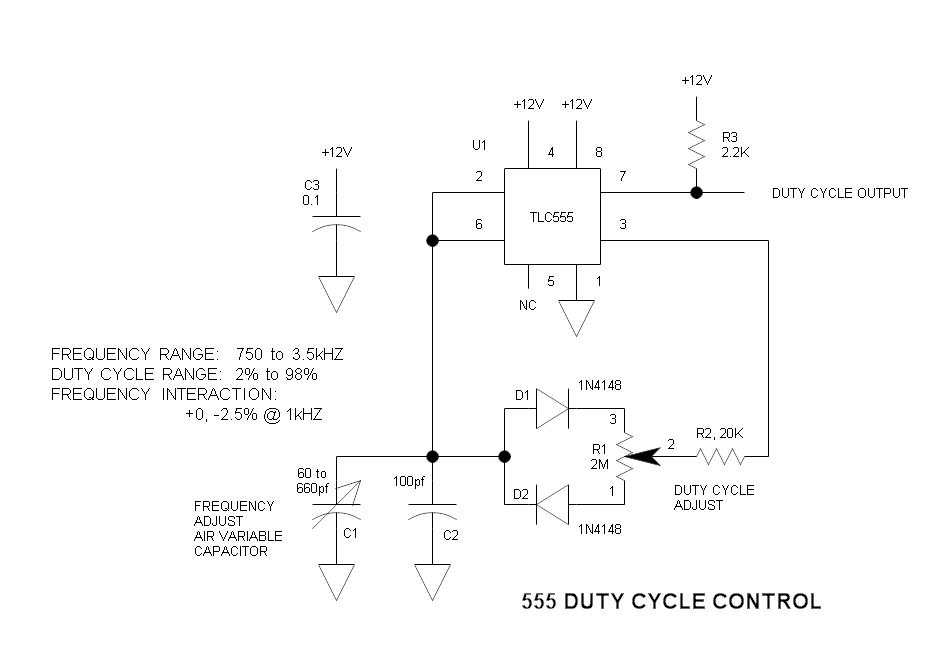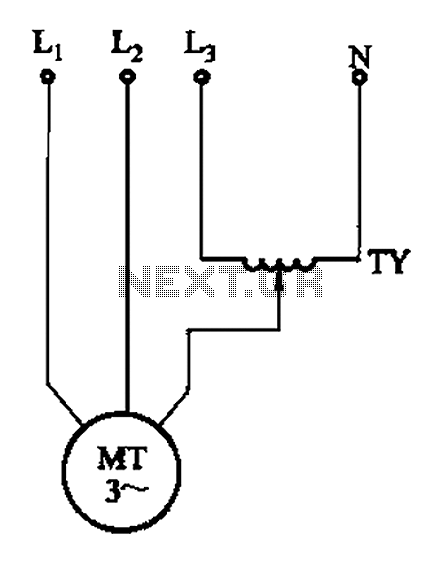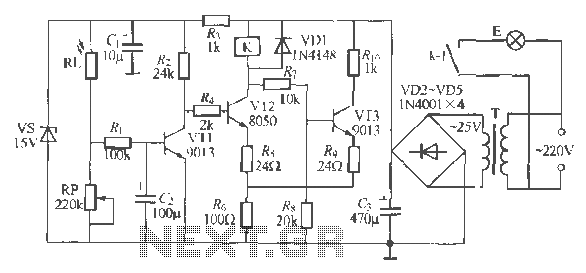
555 Duty Cycle Control

This is a simple oscillator circuit that varies the duty cycle over a wide range without affecting the frequency. It is a variation of the simple 555 astable multivibrator.
The oscillator circuit utilizes the 555 timer IC configured in astable mode, which allows it to continuously oscillate between high and low states. The key feature of this design is its ability to adjust the duty cycle, which is the proportion of time the output is high compared to the total period of the oscillation, without changing the frequency of the output signal.
The circuit consists of a 555 timer, resistors, and capacitors. The frequency of oscillation is determined by the values of two resistors (R1 and R2) and a capacitor (C1) connected to the 555 timer. The duty cycle can be manipulated by varying the resistance of R2 while keeping R1 constant. This approach allows for a broad range of duty cycles to be achieved, making the circuit versatile for various applications.
In this configuration, the output frequency (f) can be calculated using the formula:
\[ f = \frac{1.44}{(R1 + 2R2) \cdot C1} \]
The duty cycle (D) is given by:
\[ D = \frac{R2}{R1 + 2R2} \]
By adjusting R2, the duty cycle can be varied while the frequency remains stable, provided that the capacitor value remains unchanged. This characteristic makes the circuit suitable for applications requiring pulse-width modulation (PWM) such as motor speed control, LED dimming, and signal generation.
It is important to select appropriate values for R1, R2, and C1 to achieve the desired frequency and duty cycle range. Additionally, the 555 timer should be powered with a suitable voltage supply, typically between 4.5V and 15V, to ensure proper operation. The output of the timer can drive loads directly or be interfaced with other circuit components for further processing.Here is a simple oscillator circuit that varies the duty cycle over a wide range without affecting the frequency. It is a variation of the simple 555 astab.. 🔗 External reference
The oscillator circuit utilizes the 555 timer IC configured in astable mode, which allows it to continuously oscillate between high and low states. The key feature of this design is its ability to adjust the duty cycle, which is the proportion of time the output is high compared to the total period of the oscillation, without changing the frequency of the output signal.
The circuit consists of a 555 timer, resistors, and capacitors. The frequency of oscillation is determined by the values of two resistors (R1 and R2) and a capacitor (C1) connected to the 555 timer. The duty cycle can be manipulated by varying the resistance of R2 while keeping R1 constant. This approach allows for a broad range of duty cycles to be achieved, making the circuit versatile for various applications.
In this configuration, the output frequency (f) can be calculated using the formula:
\[ f = \frac{1.44}{(R1 + 2R2) \cdot C1} \]
The duty cycle (D) is given by:
\[ D = \frac{R2}{R1 + 2R2} \]
By adjusting R2, the duty cycle can be varied while the frequency remains stable, provided that the capacitor value remains unchanged. This characteristic makes the circuit suitable for applications requiring pulse-width modulation (PWM) such as motor speed control, LED dimming, and signal generation.
It is important to select appropriate values for R1, R2, and C1 to achieve the desired frequency and duty cycle range. Additionally, the 555 timer should be powered with a suitable voltage supply, typically between 4.5V and 15V, to ensure proper operation. The output of the timer can drive loads directly or be interfaced with other circuit components for further processing.Here is a simple oscillator circuit that varies the duty cycle over a wide range without affecting the frequency. It is a variation of the simple 555 astab.. 🔗 External reference
Warning: include(partials/cookie-banner.php): Failed to open stream: Permission denied in /var/www/html/nextgr/view-circuit.php on line 713
Warning: include(): Failed opening 'partials/cookie-banner.php' for inclusion (include_path='.:/usr/share/php') in /var/www/html/nextgr/view-circuit.php on line 713





